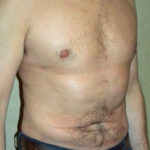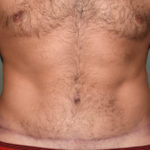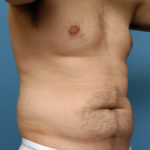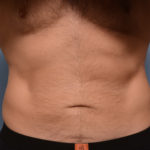When men seek body contouring, the vast majority of cases will involve the abdomen and waistline liposuction. It is very rare to ever do in a man any other areas that are more common in women such as the hips, buttocks, or thighs. In my Indianapolis plastic surgery practice, I can not even remember ever having done liposuction in these areas in a man.
The distribution and collection of fat in a man is uniquely different from that in a woman. Men collect fat in a largely central distribution, being around the abdomen and waistline into the back. (flanks) But fat accumulation in men also has a significant deep central component, that of inside the abdominal cavity around the organs. Large abdomens in men are always associated with a significant intraperitoneal collection of fat which is treatable only by weight loss. One can not suction inside the abdominal cavity.
This intraperitoneal collection of fat in men is easily demonstrated by examination. First, note the very hard enlarged abdomen that many men have. Their stomachs are like a watermelon, very firm to the tough. This is because the intraperitoneal fat is pushing out behind the abdominal muscles making the outward skin and fat layer (between the muscles and skin) firm and tense. Large abdomens in most women are much softer because a larger percentage of their fat is between the abdominal muscles and the skin. (preperitoneal fat) Secondly, how much the intraperitoneal fat is contributing to that belly shape can be demonstrated by comparing its appearance in the standing and laying position. The difference in the belly’s appearance between the two is the contribution of the intraperitoneal fat component. This directly means that the liposuction result will not usually be better than how the belly appears when you are laying flat.

There currently is considerable debate about what type of liposuction to use or which type is better. While there are advantages to Smartlipo in my experience (less bruising and pain, better skin contraction), those advantages become less important as the size of the liposuction project becomes bigger. But the most important element of any liposuction procedure, like any plastic surgery, is who is driving the technology or using the instruments.

Dr. Barry Eppley
Indianapolis, Indiana




